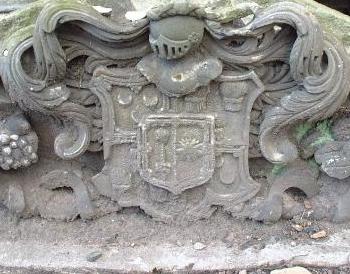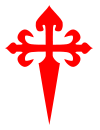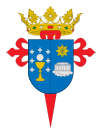|
 The
Arms of the Seton's The
Arms of the Seton's
The Seton's were known for their
bold display of armorial devices, which occupied prominent
positions and decorated their places of residence.
So noted in fact, that even Sir Walter Scott wrote in detail
those of Lord Seton's Lodging in the Cannongate, near the
Royal Palace of Holyroodhouse in Edinburgh.
Written as such:
"...a paved court, decorated with large formal vases of stone,
in which yews, cypresses, and other evergreens, vegetated in sombre sullenness, and gave a
correspondent degree of solemnity to the high and heavy building
in front of which they were placed as ornaments, aspiring towards
a square portion of the blue hemisphere, corresponding exactly in
extent to the quadrangle in which they were stationed, and all
around which rose huge black walls, exhibiting windows in rows of
five stories, with heavy architraves over each, bearing armorial
and religious devices."
"Roland Graeme... too, pulled the
bobbin, and the latch, though heavy and massive, answered to
the summons, and arose. The page entered with the same
precipitation which had marked his whole proceeding, and found
himself in a large hall, or vestibule, dimly enlightened by
latticed casements of painted glass, and rendered yet dimmer
through the exclusion of the sunbeams, owing to the height of
the walls of those buildings by which the court-yard was
enclosed. The walls of the hall were surrounded with
suits of ancient and rusted armour, interchanged with huge
and massive stone escutcheons, bearing double tressures, fleured
and counter-fleured, wheat-sheaves, coronets, and so forth..."
Sir Walter Scott's, "The Abbott".
Examples of the Arms of the
Seton's of Barnes line are:
Or, a sword in pale az. between
three crescents, within a double tressure flory counter-flory
gu. Andrew SETON, merchant, London (1766).
Or, a sword in pale ppr., supporting on its point an
imperial crown between three crescents gu., within a double
tressure flory counter-flory of the last (1st and 4th
quarters). Lieut.-Col. James Seton, Governor of St. Vincent
and the Grenadines (1806).
The arms of Alexander Seton, Lord
Urquhart is 1588, his earlier seal, an ecclesiastical vesica,
had the basic Seton arms differenced only by a Crosier
placed behind the shield and the legend Priorus de
Pluscarden. Thereafter he added a Fess charged with
three Cinquefoils for his maternal descent from Hamilton of
Sanquhar. Subsequently he became one of the Octavians,
being created Lord Fyvie in 1598 and finally Earl of
Dunfermline in 1605. His arms are blazoned Quarterly,
1st and 4th, Or, three crescents within a double tressure
flory counterflory Gules (Seton); 2nd and 3rd, Argent, on a
fess Gules, three cinquefoils Argent.
Pont states the latter quarters
represent the Earldom of Dunfermline, and on the death of
the 4th Earl, the Seton's of Barnes descended from Sir John
Seton of Barnes (d.1594), the elder brother of the 1st Earl,
became heirs of line. They bore a "sword" in pale
Azure, hilted and pommelled Or, supporting an imperial crown
proper between the three crescents and Royal tressure all
Gules. MacKenzie states that the lands of Barnes were
granted to the Seton's with the sword as a charge of
augmentation by Robert I. Bruce A. McAndrew, though
wrong, had felt that this seemed unlikely on two grounds
because first he saw no record of it till the appearance of
the sword in the Winton inescutcheon, a gap of 300 years;
and second that the seal of Sir John Seton of Barnes is
difference with a cross-crosslet fitchy, readily mistaken
for a sword.
In actual fact, with the grant of
Arms, and in Seton paper's notes, the augmentation of the
sword and crown have been noted. It was only out of
good taste, and perhaps modesty that the coat was not borne.
With the Winton Honours, it was fully appropriate to add the
augmentation, and thus is was done. What is not
mentioned or illustrated further however, is that Sir John
Seton of Barnes was created a a Knight of the Order of St.
James of Calatrava, or of
St Iago (Jago), at that time the order of knighthood in
that kingdom of greatest esteem. In memory whereof, he and
his heirs has a sword in their coat of arms, being the Badge
of that Order, and McAndrew assuming that to being the
cross-crosslet fitchy, when in fact it is not.
What should be remembered then,
is that Saint Iago (Jago) refers to St. James of Compostela,
or simply as Santiago de Compostela. From
Spanish, from
Santiago, a combination of "Sant’ Iago", and "Saint
James".
Sant is from Latin
Sanctus, "holy" or "saint".
Iago is a northwestern Spanish form from Latin
Jacobus, "James". Legend holds that
St. James's remains were carried by boat from Jerusalem
to northern Spain where he was buried on the site of what is
now the city of Santiago de Compostela.
This is the According to legend,
the apostle Saint James the Greater brought the Message of
Christ to the
Celts in the Iberian Peninsula. In 44 AD he was beheaded
in
Jerusalem. His remains were later brought back to
Galicia,
Spain. Following Roman persecutions of Spanish
Christians, his tomb was abandoned in the 3rd century. Still
according to legend, this tomb was rediscovered in 814 AD by
Pelayo, a hermit, after witnessing strange lights in the
night sky. Bishop Theodemir of Iria recognized this as a
miracle and informed the
Asturian king
Alfonso II (791-842). The king ordered the construction
of a chapel on the site, and this chapel grew into the
Cathedral of Santiago, also associated with the Knights
Templar, and the Order of St. Iago, to which King Philip II
invested Sir John Seton of Barnes.
The Order of St. James does not
use the cross crosslet fitchy. The Order uses the
emblem of the twelfth-century military
Order of Santiago, named in reference to Spain's patron
saint,
Saint James the Great. This cross design is also called
the Cross of the Knights of Santiago, as well as the Spanish
Cross, and the cross design bears a heart-like ornament on
its top supporting a crown.
The arms of Sir John Seton of
Barnes then, should reflect the following Cross of Santiago
supporting a crown:


Cross of Santiago Cathedral and
Order of Santiago |

